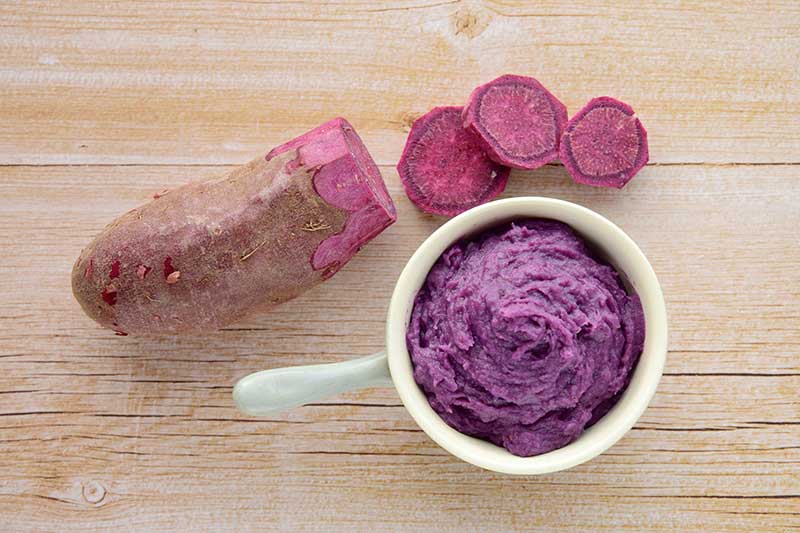
Welcome to our comprehensive guide on purple yam allergies. If you have ever experienced allergic reactions after consuming purple yam or suspect that you may have a purple yam allergy, this article is for you. We will cover everything you need to know about purple yam allergy symptoms and how to effectively manage them.
Purple yam allergies are a relatively common condition that can cause uncomfortable symptoms. It is essential to identify these symptoms early on to seek appropriate care and prevent further allergic reactions. By understanding the signs of a purple yam allergy, you can take proactive steps to manage and prevent future allergic reactions.
Key Takeaways:
- Purple yam allergies can cause a range of symptoms, including itching, hives, swelling, and digestive issues
- Careful identification and avoidance of purple yam and related foods can help manage the allergy
- Antihistamines and other medications can provide relief from purple yam allergy symptoms
- Reading food labels, practicing cross-contamination prevention, and allergen awareness are essential for preventing purple yam allergies
- Seeking professional medical advice and support is crucial for individuals with severe or recurring purple yam allergy symptoms
Identifying Purple Yam Allergy Symptoms
Allergies to purple yam can result in a range of symptoms that vary in severity from person to person. Recognizing these symptoms is crucial in seeking appropriate care and avoiding further allergic reactions. Here are the common symptoms of a purple yam allergy:
- Skin reactions: Rashes, hives, and itching are typical allergic responses to consuming purple yam. These symptoms may appear shortly after ingestion or contact.
- Gastrointestinal issues: Some individuals may experience stomach pain, nausea, vomiting, or diarrhea after consuming purple yam.
- Respiratory symptoms: Allergic reactions to purple yam can also affect the respiratory system, causing symptoms such as nasal congestion, sneezing, coughing, and wheezing.
- Swelling and itching of the lips, tongue, or throat: In severe cases, purple yam allergy can lead to swelling in the mouth and throat, making it difficult to breathe.
- Anaphylaxis: Although rare, severe allergic reactions to purple yam can trigger anaphylaxis, a life-threatening condition that requires immediate medical attention. Symptoms of anaphylaxis include difficulty breathing, dizziness, rapid heartbeat, and loss of consciousness.
If you experience any of these symptoms after consuming purple yam or any purple yam-containing products, it is advisable to consult with a healthcare professional for proper diagnosis and treatment. Avoiding further exposure to purple yam is essential to prevent allergic reactions and ensure your well-being.
Managing Purple Yam Allergies
For individuals with a purple yam allergy, effective management is key to preventing allergic reactions and maintaining a healthy lifestyle. In this section, we will explore different methods to manage purple yam allergies and provide helpful tips on treatment options and prevention strategies.
Treatment Options
If you experience allergic reactions to purple yam, it is essential to consult a healthcare professional for proper diagnosis and treatment guidance. Treatment options may include:
- Antihistamines: Antihistamines are commonly used to relieve the symptoms of allergic reactions, such as itching, swelling, and rash. They work by blocking the effects of histamine, a chemical released during an allergic response.
- EpiPen (Epinephrine autoinjector): In severe cases of purple yam allergy, an Epinephrine autoinjector, commonly known as an EpiPen, may be prescribed. This device delivers a dose of epinephrine, which can help reverse life-threatening symptoms, such as difficulty breathing, low blood pressure, or anaphylaxis.
- Immunotherapy: Immunotherapy, also known as allergy shots, may be recommended for individuals with severe purple yam allergies. This treatment involves regular injections of small amounts of the allergen to desensitize the immune system over time, reducing the severity of allergic reactions.
Prevention Tips
To prevent future allergic reactions to purple yam, it is important to be proactive. Here are some tips:
- Avoidance: The most effective way to prevent an allergic reaction is to avoid consuming purple yam and any products that contain it as an ingredient.
- Read Food Labels: When grocery shopping, carefully read food labels to check for the presence of purple yam or any derivatives.
- Cross-Contamination: Be cautious of cross-contamination in food preparation areas. Purple yam can potentially come into contact with other foods, utensils, or surfaces, leading to accidental ingestion.
- Allergen Awareness: Educate yourself and others about purple yam allergy symptoms and how to respond in case of an allergic reaction. This knowledge can help minimize the risk of accidental exposure.
By following these management and prevention strategies, individuals can effectively navigate life with a purple yam allergy and reduce the likelihood of allergic reactions.

Prevention Tips for Purple Yam Allergies
While purple yams are a delicious and nutritious addition to many dishes, some individuals may be at risk of developing an allergy to them. However, there are several preventive measures that can help minimize the risk of purple yam allergy. By incorporating these strategies into your daily routine, you can enjoy the benefits of purple yams while keeping allergic reactions at bay.
- Read Food Labels: When shopping for groceries or dining out, make it a habit to read food labels carefully. Look for any ingredients that may contain purple yams or related derivatives. Familiarize yourself with common names for purple yams, such as “ube” or “purple sweet potato,” to ensure you can easily spot them on ingredient lists.
- Practice Cross-Contamination Prevention: If you have a purple yam allergy, it is crucial to prevent cross-contamination in your kitchen. Clean utensils, cutting boards, and surfaces thoroughly to avoid traces of purple yam coming into contact with other foods. It’s also advisable to use separate kitchen tools when preparing dishes with purple yams and for other ingredients.
- Be Allergen Aware: Stay informed about potential cross-reactivity between purple yams and other allergenic foods. People who are allergic to other tubers or root vegetables, such as potatoes or taro, might also be at risk of developing a purple yam allergy. By knowing these associations, you can make informed decisions about your diet and reduce the likelihood of accidental exposure.
- Consider Allergy Testing: If you suspect a purple yam allergy or have a history of allergic reactions to similar foods, consider consulting an allergist for testing. Allergy tests can help identify specific triggers and guide you in managing your condition effectively. Your allergist may also provide personalized recommendations for prevention and treatment.
By adopting these preventive measures, individuals can significantly reduce their risk of developing a purple yam allergy. Remember, while purple yams offer various health benefits, it is always essential to prioritize your well-being and take necessary precautions to avoid allergic reactions.
| Prevention Tips for Purple Yam Allergies | Benefits |
|---|---|
| Read food labels | Avoid accidental consumption |
| Practice cross-contamination prevention | Minimize the risk of allergic reactions |
| Be allergen aware | Make informed decisions about your diet |
| Consider allergy testing | Receive personalized recommendations |
Conclusion
Throughout this article, we have provided valuable information on purple yam allergies, their symptoms, management, and prevention. It is essential to understand the importance of proper identification, as allergic reactions can vary in severity from person to person. By recognizing the symptoms, individuals can seek appropriate care and take necessary precautions to prevent future allergic reactions.
Managing purple yam allergies involves a combination of treatment options, including the use of antihistamines and avoiding trigger foods. It is crucial to consult a healthcare professional for personalized advice and guidance. Additionally, practicing preventive measures like reading food labels, maintaining allergen awareness, and preventing cross-contamination can significantly reduce the risk of developing a purple yam allergy.
If you would like to learn more about purple yam allergies, we recommend referring to our comprehensive Purple Yam Allergy Guide. This guide offers in-depth information, tips, and resources to help you better understand and manage purple yam allergies. Remember, prioritizing your health and taking proactive measures is the key to living a safe and allergen-free life.
